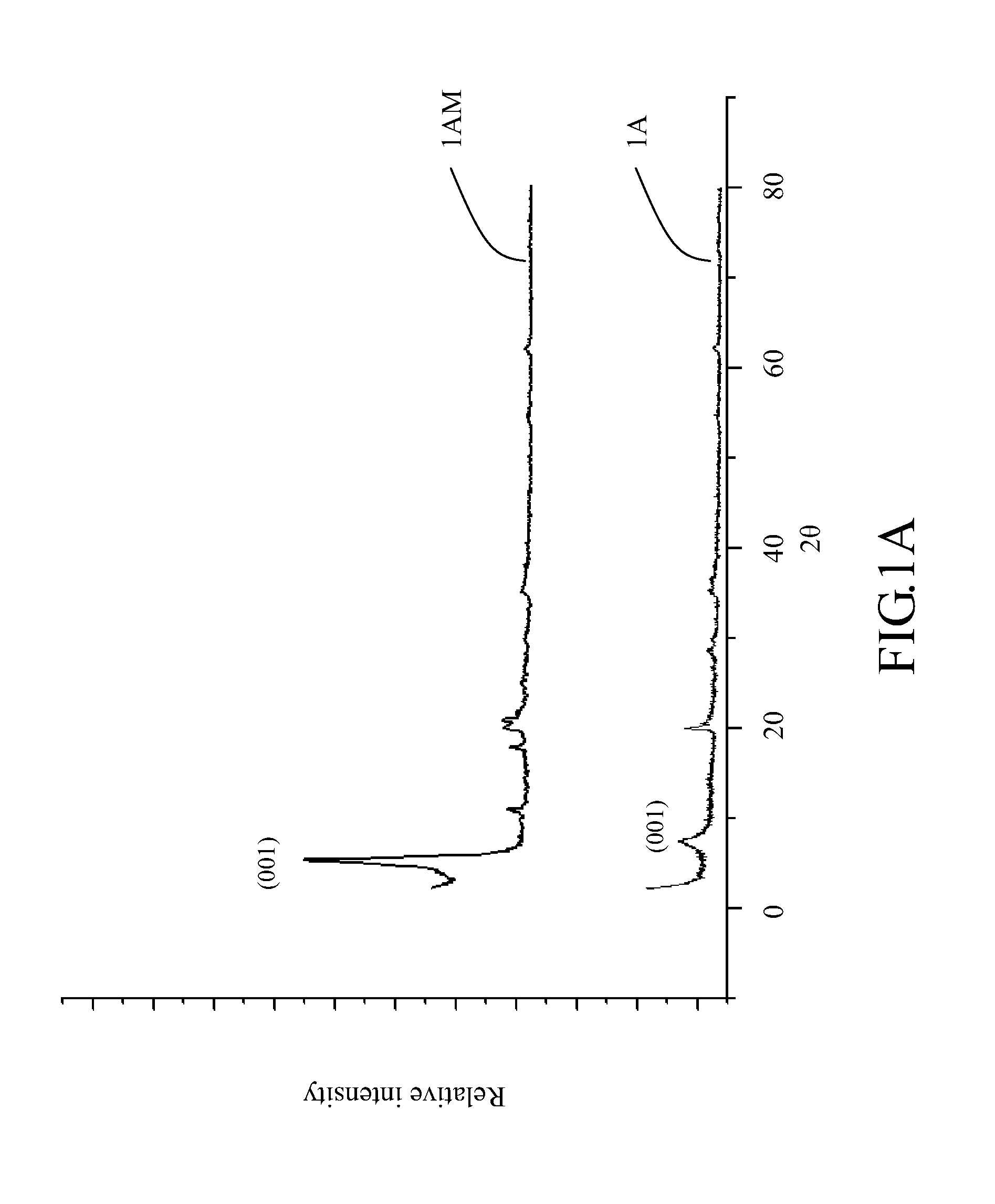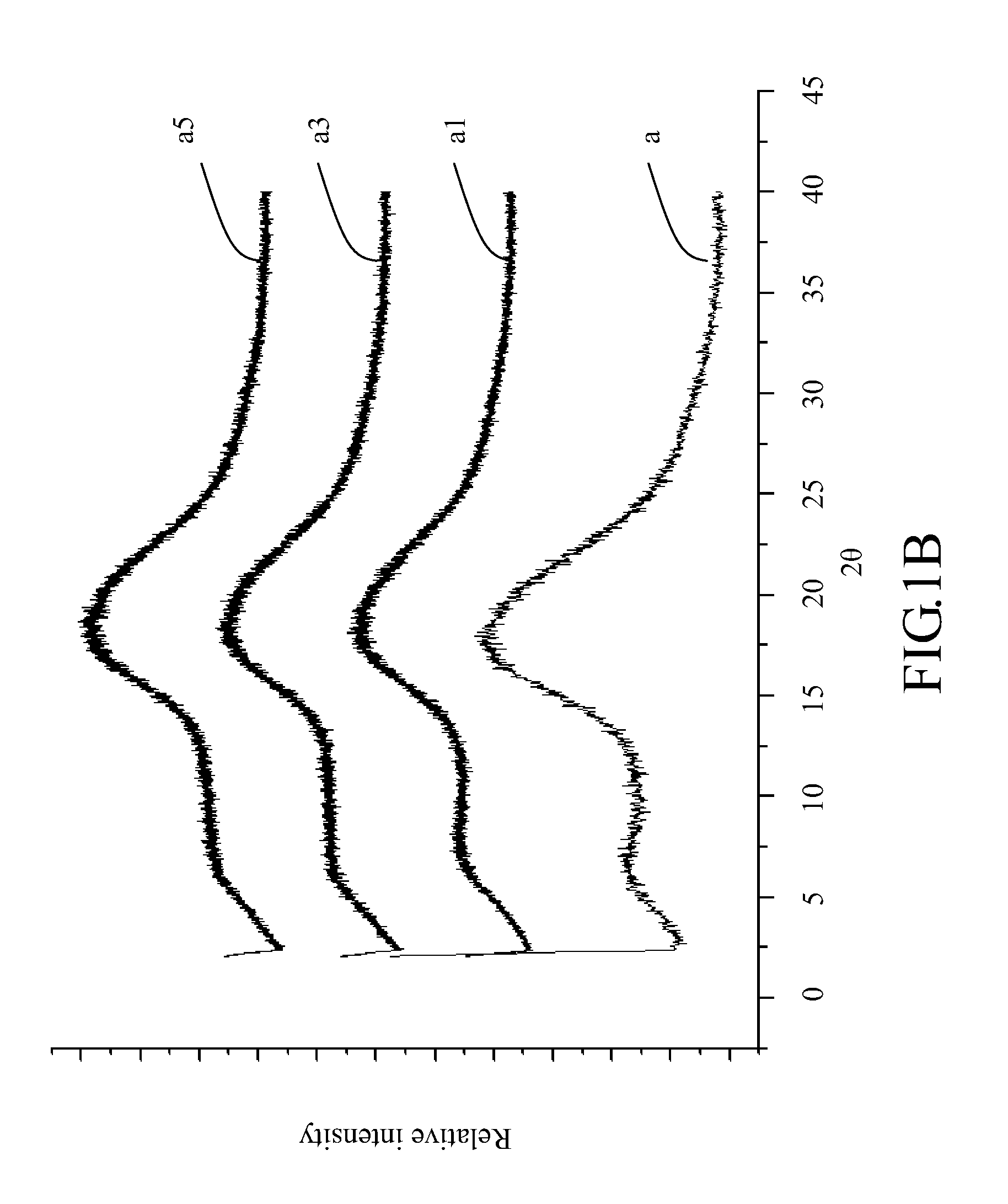Modified clay and clay-polymer composite
a technology of clay and polymer, which is applied in the field of modified clay, can solve the problems of serious environmental problems, easy damage to the polymer material by softening or burning, etc., and achieve the effect of preventing further thermal cracking of the polymer material
- Summary
- Abstract
- Description
- Claims
- Application Information
AI Technical Summary
Benefits of technology
Problems solved by technology
Method used
Image
Examples
example 1
[0038]Modifying the Clay (Montmorillonite) by C60
[0039]C60 powder was first modified. 10 g of C60 was added into a solution of 0.414 g of formaldehyde and 2.416 g of N-methylglycine. Then, the solution was reflowed at 110° C. for 2 hours and dried to obtain a modified C60 powder. The modified C60 powder was further added into a solution of 16.7 ml of 0.1N HCl and 5.934 g of benzalkonium chloride and stirred to form a modifier.
[0040]2.89 g of montmorillonite was added into deionized water for 24 hours to obtain a clay solution. The clay solution was added dropwisely into the modifier to perform a cation exchange between the modifier and the layered clay material (montmorillonite). The cation-exchange capacity of montmorillonite was about 116 meq / 100 g. Then, 1N HCl was used to adjust the pH value of the mixture to be between 3 and 4. The mixture was stirred overnight.
[0041]The mixture was centrifuged and the clay on the bottom was taken out. The clay was washed by deionized water an...
example 2
[0045]Modifying the Layered Double Hydroxide (LDH) by Imidazole
[0046]First, layer double hydroxide (in this example, [LiAl2]LDH) was formed. A mixture of 7.28 g of LiNO3.3H2O and 78.82 g of Al(NO3)3.9H2O was dissolved in 400 ml of deionized water, followed by adding of 50.4 g of NaOH. The mixture mentioned above was stirred for 1 hour and the pH value of the mixture was maintained at 13. Then, the mixture was put into a autoclave at 100° C. for 24 hours. The mixture was centrifuged repeatedly and the clay on the bottom was washed, dried, and ground to obtain a powder of [LiAl2]LDH. The obtained layered double hydroxide had an anion-exchange capacity of about 420 meq / 100 g.
[0047]4,5-imidazole dicarboxylic acid was dissolved in 200 ml of deionized water to form a modifier. 6.3 g of [LiAl2]LDH was dissolved in deionized water and stirred for 24 hours to obtain a clay solution. Then, the clay solution was added dropwisely into the modifier and kept at 50° C. for 2 days to perform an ani...
example 3
[0051]Modifying the Clay (Montmorillonite) by C60
[0052]Example 3 is similar to Example 1. The main difference between Example 3 and Example 1 is that benzalkonium chloride was not used to modify the layered clay material in Example 3.
[0053]C60 powder was first modified. 10 g of C60 was added into a solution of 0.414 g of formaldehyde and 2.416 g of N-methylglycine. Then, the solution was reflowed at 110° C. for 2 hours and dried to obtain a modified C60 powder. The modified C60 powder was further added into a solution of 16.7 ml of 0.1N HCl and stirred to form a modifier.
[0054]2.89 g of montmorillonite was added into deionized water for 24 hours to obtain a clay solution. The clay solution was added dropwisely into the modifier to perform a cation exchange between montmorillonite and the modified C60. The cation-exchange capacity of montmorillonite was about 116 meq / 100 g. Then, 1N HCl was used to adjust the pH value of the mixture to be between 3 and 4. The mixture was stirred ove...
PUM
| Property | Measurement | Unit |
|---|---|---|
| thermal cracking temperature | aaaaa | aaaaa |
| thermal cracking temperature | aaaaa | aaaaa |
| cracking temperature | aaaaa | aaaaa |
Abstract
Description
Claims
Application Information
 Login to View More
Login to View More - R&D
- Intellectual Property
- Life Sciences
- Materials
- Tech Scout
- Unparalleled Data Quality
- Higher Quality Content
- 60% Fewer Hallucinations
Browse by: Latest US Patents, China's latest patents, Technical Efficacy Thesaurus, Application Domain, Technology Topic, Popular Technical Reports.
© 2025 PatSnap. All rights reserved.Legal|Privacy policy|Modern Slavery Act Transparency Statement|Sitemap|About US| Contact US: help@patsnap.com



